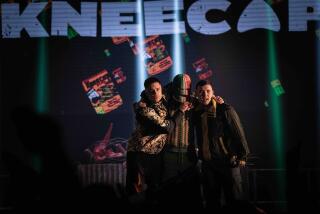A Slice of the Struggle : THE IRISH TROUBLES: A Generation of Violence, 1967-1992, <i> By J. Bowyer Bell (St. Martin’s Press: $35; 944 pp.)</i>
Yes, a war continues in Northern Ireland: People are killed and maimed; bombs go off with dreadful regularity in both London and Belfast. But the public’s attention wandered long ago from these events. The idea that a war could go on for 25 years, as the subtitle of J. Bowyer Bell’s book indicates, is probably reason enough for the loss of interest in the media and the public.
There is no way to understand the present, in particular in Ireland, without being aware of the past. In the case of Northern Ireland, the history of the conflict goes back 900 years to the invasion of Ireland by Henry II in 1171 (who, ironically, had received a Papal Bull from Pope Adrian IV granting him permission to invade Ireland in order to reform the Irish church).
Northern Ireland was and is a peculiar place. It was created arbitrarily by the English so as to secure a permanent Protestant majority and that majority has, since 1921, built into both law and practice, according to Mr. Bell, a complex web of discriminatory practices designed to keep the Catholic minority in a poor and helpless position. Pathetic attempts were made between 1921 and 1967 to change that reality but nothing came of them except to reinforce the Protestant majority’s resolve to hold on without compromise.
In “The Irish Troubles,” Bell has chosen the difficult task of excerpting only the last 25 years of the conflict. He aspires to having written the definitive history of these years, and he describes them in numbing detail that overwhelms both the author and the reader. One feels as if one has read 25 years of newspaper clips. But with no historical perspective there is no way to really understand the significance of any of the details.
Bell does a good job sorting out the various political forces in the conflict and is especially helpful in understanding the para-military organizations engaged in the struggle. Since he is by profession a political analyst rather than a historian, this is not surprising. He has also written two studies of the IRA, and reveals his republican sympathies in this new book, which sometimes hampers his portrayal of the Loyalist or Unionist position. Bell sometimes calls himself “The Yank,” interspersing numerous asides, which call to mind one of the favorite words of Flann O’Brien, blather, as for instance: “The decent nationalists, the decent Unionists even in opposition, provide the agar for the bacilli of the faithful. They have done the usual, the amenable, the normal thing, have kept not silent but too still too long.” This provides yet another clue as to why the book runs on for 872 pages.
Bell reports in his reductive social science manner all the well-known events of these years: the rise of the civil right’s movement in the north, the inevitable confrontation with the Protestant Unionist Establishment, the subsequent violent disorders, which lead to the calling in of the British Army to protect the Catholic ghettos. He marches the reader through the resurrection of the IRA, which he points out, contrary to legend, had been reduced in 1969 to having on hand in Belfast an armory consisting of three submachine guns, a rifle and nine handguns.
Since the struggle is not finished there is a feeling of futility to the story Bell tells: the tit-for-tat killings, the saga of the hunger strikers, the various political maneuverings by the governments in London and Dublin--all pass in homage to this first ideology of race and religion. Bell describes the typical political killing:
“These four or five taciturn men, farmers by trade, killers by choice or necessity . . . battered down a reinforced door with a sledge and burst into the small front hall of an isolated house. The driver will have waited down the lane . . . the others will have raged up the stairs, smashed the locked plywood door into a bedroom, and shot, over and over to be sure, one of them. The victim will have died, still dazed, next to his screaming wife, with the children howling through the wall and the chained dogs barking at murder done. And the killers will have gone, and the dead man will be buried in a day or two, to recriminations and pleas for reconciliation and rituals of despair.”
What an opportunity Mr. Bell has missed. If only he had read deeply and meditatively in the forming past his account of these last twenty-five years would be definitive. He claims to have read and to be aware of nearly everything written on the conflict both in English and in other languages. He has compiled “tens of thousands of hours of interviews.” But rarely are these interviews used verbatim so a reader could judge for him or herself the accuracy of Bell’s characterization.
The lesson of these 944 clotted and industrious pages could be summed up better by a joke told in London: An Irishman was sitting next to a West Indian in a pub in London. The Irishman leans over to your man and says, “You wouldn’t be Irish, now would you?”
More to Read
Sign up for our Book Club newsletter
Get the latest news, events and more from the Los Angeles Times Book Club, and help us get L.A. reading and talking.
You may occasionally receive promotional content from the Los Angeles Times.






